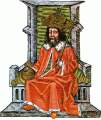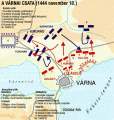the long campaign, the battle of Várna, the battle of Rigómező
| |
| |
| |
| |
| |
|
The campaign against the Osmans was initiated by Wladislas I. Its main objective was to take over the capital city, Drinaple (today's Edirne). The Polish-Hungarian army set off from Buda on 22 July, 1443. There were about 35,000 soldiers in this army. The commander-in-chief was John Hunyadi, the Transylvanian voivode. They pressed forward through the valley of Morava and had a victory at Krusevac. They occupied Nis and Sophia. The winter slowed down their progress and a horse plague in the camp made matters worse. They could not break through the Turkish defence line at the Slatica pass. Then they retreated, but defeated the Osman armies which started to chase them. They returned to Nándorfehérvár on 25 January, 1445.
IT
the battle of Várna
This was part of the crusade initiated by Wladislas I against the Osmans. Its objective was to conquer the Balcans. The Polish-Hungarian troops crossed the border at Orsova on 22 September, 1444, and there were 20,000 men in the army, after soldiers from the Havasalföld joined them. On 16 October they occupied the fortress of Nicapole, then on 9 November Várna. The Anatolian troops crossed the straits and met the Rumelians (Europeans). The commander of this huge army was Murad II. The battle took place on 10 October, and it lasted from morning to evening. At first the crusaders had the upper hand, but after the Hungarian king's death the Turks defeated the Hungarians. Those who retreated were not pursued. In total 4,000 soldiers of the crusaders were either killed or taken captive, but the losses on the Osman side were even greater.
IT
the battle of Rigómező
The main battle against the Osmans in 1448 was initiated by governor John Hunyadi. The objective of this campaign was to unite with the army of the Albanian Bey Scander and to occupy the Balcans. There may have been around 30,000 men in the Hungarian-Wallachian army. They left the Danube on 28 September, and passing Krusevac they marched towards Albania. Sultan Murad II was waiting for them there with an army of 70-80,000 troops. They met at Kosovo Pole (Rigómező) on 16 October, where the battle was started in the morning by Hunyadi. Neither side was able to defeat the other even by the time evening drew in, and the stalemate could not be resolved by night attacks either. The following day the cavalry did not manage to break through the line of the Yanichars, so the Christians lost the battle and several dignitaries died. The infantry started to retreat to wagon fortresses, and the escaping soldiers were not pursued by the sultan's army.
IT





